It is surprising how the meaning of a term can shift over time. As a concept achieves acceptance and is subjected to broader application, it may outgrow its original appellation and acquire a new one. Alternatively, the original name might be retained long after the concept has evolved into something quite different. It would appear that the latter has occurred in the case of the term "hypermeter." This essay examines the shifting meanings of this controversial term, and raises some general questions concerning analytical implications of its several meanings. An analysis of the first movement of Beethoven's Quartet in  , Op. 127 demonstrates both advantages and limitations of hypermetrical analysis, and the author subsequently proposes an alternative perspective on its overall design.
, Op. 127 demonstrates both advantages and limitations of hypermetrical analysis, and the author subsequently proposes an alternative perspective on its overall design.
Invention of the term "hypermeter" is generally credited to Edward T. Cone, who first employed it in his study Musical Form and Musical Performance.1 In the first of the book's three essays, Cone proposes that musical form is a large-scale manifestation of rhythmic structure, and suggests that one key to understanding such formal rhythms may lie in the rhythmic structure of the individual phrase. But although he writes of "structural downbeats" and greatly enlarges the spans over which certain rhythmic principles apply, he does not employ the term "hypermeter" at this point. Cone is clearly aware that a regular metrical hierarchy seldom extends far beyond the notated measures in most tonal music, and he is sharply critical of attempts to carry the properties of surface meter to higher levels:
The classical phrase has often been analyzed as an alternation of strong and weak measures, on an analogy with strong and weak beats within a measure. In other words, the larger rhythmic structure is treated simply as metric structure on a higher level. Now I do not deny that such alternation occurs, especially in the case of short, fast measures; but I insist that on some level, this metric principle of parallel balance must give way to a more organic rhythmic principle that supports the melodic and harmonic shape of the phrase and justifies its acceptance as a formal unit. (p. 26)
For Cone, the "metric principle" requires alternation of strong and weak in regularly recurring periodic patterns. The model he develops for the accentual patterning of the typical phrase, however, is fluid and asymmetrical. It is anchored by initial and cadential downbeats (which, in spite of their similar names, differ in important ways), but it need not exhibit an alternation of strong and weak measures, and its length is not strictly fixed. This model admits of internal expansion, and may also carry a prefix (functionally, an upbeat), a suffix (an afterbeat), or both. In short, according to its inventor, this model does not conform to the requirements of metric principles (it is not a hypermeasure), but answers instead the need for "a more organic rhythmic principle."
Cone first uses the term "hypermeasure" in the second essay in Musical Form and Musical Performance. He suggests that in Chopin's Prelude in A Major, pairs of measures can themselves be heard as metrical entities. Yet he promptly warns against forcing the piece into a four-bar or larger hypermetrical grid:
The obvious two-by-two balance of these motivic hypermeasures might tempt us to continue this combination on still higher levels, arriving at a uniform pattern. But any such trial—whether based on the strong-weak organization of the hypermeasure, or reversing it at higher levels—is bound to show . . . the shortcoming of all attempts to invoke mechanically at higher levels the metrical arrangement of beats within a measure (or measures within a hypermeasure). (p. 40)
Here again, Cone opts for flexible models, eschewing "mechanical" regularity.
Only in the third and final essay does Cone introduce the term "hypermeter," and with distinctly negative overtones. Denouncing the "tyranny of the four-measure phrase" (p. 79) that plagues certain Romantic works, Cone notes:
The composer who really absorbed, digested, assimilated, and nourished himself on the four-measure concept was Chopin. In his dances, and in movements derived from dance forms, the hypermeasures are obvious to the ear and sometimes overly persistent. Other compositions, however, exhibit the same pattern firmly in control, yet concealed with a subtlety that mitigates the hypermeter without violating it. (p. 80)
Regular successions of hypermeasures may produce an undesirable effect, then—one that Chopin (in his most successful works) mitigates and conceals.
In a recent retrospective essay entitled "Musical Form and Musical Performance Reconsidered," Cone adds supporting arguments for his flexible phrase model (noting, for example, how traditional hemiola cadences disrupt prevailing alternation of strong and weak in surface meters). He also advances new ideas about introductions and codas and their metaphorical or actual relationship to upbeats and downbeats in metrical schemes.2 But Cone repeats his rejection of strictly metrical modelling of the typical tonal phrase. At one point he chides Wallace Berry, because "insisting on the primacy of a pattern of alternation, he neatly turns the standard phrase into a hypermeasure" (p. 156). Cone reiterates his commitment to fluid models, stating: "The most useful systems are the most flexible" (p. 158). Significantly, he never employs the word "hypermeter."
Given Cone's infrequent and decidedly negative use of the term, it seems ironic that "hypermeter" has come to figure so prominently in recent discussions of rhythm and meter. The transformation has been gradual, and was not accomplished by a single individual, but the term has now acquired a distinctly different flavor. Not surprisingly, among the strongest advocates for a new style of hypermetrical analysis are those who espouse the analytical methodology of Heinrich Schenker. Despite Cone's admonitions and Schenker's own declaration that meter emerges only in relatively foreground levels, some analysts are quite willing to experiment with deep extensions of the metrical hierarchy, presumably in the hope of discovering analogues for Schenker's powerfully explanatory theories of hierarchic tonal structure. Carl Schachter's exemplary series of articles on "Rhythm and Linear Analysis" in The Music Forum provides an invaluable critical review of the most important of these attempts, and clearly demonstrates how radically attitudes toward hypermeter have shifted over the course of time.3
The term does not appear in Schachter's first article, "A Preliminary Study." Throughout, Schachter expresses skepticism about efforts to discover and explain large-scale rhythm and meter, and he repeatedly warns of the difficulties of this "slippery terrain" (p.303). His critique of Arthur Komar's Theory of Suspensions is especially pointed in this regard:
That meter does, in fact, operate over such long spans of time—that we can assume a metrical relationship of strong and weak between two downbeats separated by lines or even pages of music—is, I think, open to legitimate question. Komar does not attempt to prove the validity of his assumption, and, indeed, one could hardly prove or disprove it. (p. 308)
Even so, Schachter's references to "metrically strong" or "metrically weak" bars do show that, like Cone, he recognizes the possibility of quasi-metrical organization at least one level beyond the notated meter. (This mildly hypermetrical sort of thinking has a long history, of course, extending back at least as far as Riepel and Koch.)
In his second article, Schachter describes a technique of "Durational Reduction," and through its application a definition of hypermeter emerges:
In music with clearly defined measure groups and phrases, the use of durational reduction frequently shows a "higher-level" metrical organization of bars, an organization of "hypermeasures," to use Edward Cone's term. (p. 198)
Of course, such a "metrical organization of bars" entails regular and periodic accentuation at a level beyond the notated meter, and concerning accent, Schachter adds the following:
In my previous article, I discussed the rather prevalent view that phrases are normally end-accented. . . . I disagree with this view and follow Schenker in assuming that the final tonic of a phrase does not normally receive a metrical accent. I see no reason to believe that the metrical organization of a group of measures differs in principle from that of a single measure and assume that both are beginning- rather than end-accented. (p. 205)
At this point, an important transformation occurs. Schachter blurs the distinction between a "group of measures" (grouped by virtue of similar surface rhythms and accentual patterning) and a "phrase" (a musical segment ending with a cadence). Failing to retain the crucial distinction he drew in his first article between durational and tonal rhythm, he (like Berry) effectively turns the phrase into a hypermeasure.
Using analyses of four works by Chopin, Mozart, Beethoven, and Schubert, Schachter proceeds to demonstrate how middleground segments consisting of eight- or sixteen-bar hypermeasures underpin irregular musical surfaces. Although he is careful to specify that durational reduction will not yield equally revealing results in all cases, Schachter is clearly more optimistic concerning the explanatory power of large-scale meter than his previous article had indicated:
I don't believe that all rhythmic and metric irregularities in tonal music necessarily derive from an underlying regularity. But some surely do. (p. 205)
Further discussion of precisely how irregular phrases may be reduced to or derived from regular hypermeasures is deferred until the third and final article, "Aspects of Meter." After reviewing some of the more famous controversies among earlier theorists, Schachter defines meter and metrical accent in such a way that these terms can be applied to middleground levels. In his analyses, Schachter seeks out the largest repeated, metrically divided spans. He calculates placement of tonal events with respect to these spans, noting such features as syncopation, anticipation, and conflicts within and among the various metrical levels. He states that meter is not "always unambiguously expressed at every level," and that furthermore:
in some passages meter might not be a very significant issue; the scansion, especially at the higher levels, might not greatly influence how one hears the passage in other respects. But in general I think that something is gained from assuming at first that each passage has "a" metrical schema that regulates its rhythmic progression . . . . One interpretation . . . gives a clearer and more comprehensive account of the piece's important features . . . than any other. (p. 33)
That is, for most passages, one can determine a single, best reading of the duration and accentuation of metrical and hypermetrical units—in short, "the" hypermeter upon which the whole is anchored.
The final portion of the article concerns "transformation of metrical structures." In order to analyze music that is not entirely four-square, one must specify means by which irregular grouping structures arise at various levels of organization, and explain how these can be resolved into deeper-level regularities. For Schachter, Schenker's concept of expansion (Dehnung) points toward an answer. Regular structures, "prototypes" of four-square design, can be expanded through the addition of prefixes, suffixes, or internal expansions and interpolations ("parentheses") of various kinds.
Near the end of the article, Schachter acknowledges an important source in which these matters are treated in greater detail: William Rothstein's dissertation, "Rhythm and the Theory of Structural Levels."4 Rothstein has since published an important new study, Phrase Rhythm in Tonal Music, in which he presents the most fully developed theory of hypermeter to date.5 Although it draws upon rhythmic theories of Riepel, Koch, Riemann, and Schoenberg, Rothstein's approach is principally indebted to Schenker. Through a process of reduction and recomposition, Rothstein discovers "basic phrases" (normative, four-square prototypes) that underpin complex foregrounds much as the various forms of the Ursatz underpin tonal compositions. According to him, most tonal compositions establish a basic hypermeter that is maintained in spite of irregularities caused by expansions, elisions and phrase overlaps. Surface meter and various levels of hypermeter interact with this underlying hypermeter to create complex multi-layered designs.6 Rothstein analyzes music by Haydn, Mendelssohn, Chopin, and Wagner, showing how these composers' solutions to problems of phrase rhythm affected their compositional styles. Some readers may find Rothstein's tendency to pronounce critical judgments based on his analyses uncomfortably reminiscent of Schenker. Too much rhythmic freedom is said to result in an arbitrary or willful sounding surface, while unvarying adherence to regular hypermetrical patterning can lead to equally objectionable results. According to Rothstein, the most successful works achieve a balance involving artful exploitation of a sturdy hypermetrical grid and freely expanded phrases.
What is troubling about this is not so much a disagreement with any particular analysis (Schachter and Rothstein are superbly musical, and their analyses are highly insightful)—as a suspicion that hypermeter might be elevated to the status of an all-embracing analytical tenet, to be "assumed at first." The attendant consequences for analysis—and particularly for the understanding of metrical irregularities—are far-reaching. Obviously, a regular meter must be assumed before one can speak of metrical irregularities. But this invokes something like the chicken and egg conundrum: the assumption of underlying regularity (an imagined metrical or hypermetrical grid) colors one's perception of irregularities (the "fascinating rhythms" that captivate and entertain us). Extending the metrical hierarchy to deep levels may tend to obscure or even obliterate certain other kinds of patterning, and to deemphasize or devalue the irregularities that enliven interesting music. This is not to deny that hypermetrical analysis can shed considerable light on some questions of temporal organization. But zeal for hierarchical purity could lead to a preference for one particular kind of patterning at the expense of others. A more comprehensive analytical viewpoint, one which coordinates metrical (and hypermetrical) patterning with other features of formal design, seems preferable.
Two brief examples will illustrate. In a discussion of the Menuet of Haydn's Symphony No. 104, in D major, Schachter mentions that the initial phrase reappears in expanded form near the end of the movement (mm. 35-49): "Here the V7 is extended to two bars; the tonic, consequently, falls on a strong bar and, this time, sounds like a downbeat." Thus the expansion enhances closure, by relocating the final cadential tonic on a hypermetrical downbeat.7 Agreed. Unlike the one in m. 8, this tonic falls on the "downbeat" of a four-bar hypermeasure. But the dominant seventh harmony is not the only component of the recurring phrase that undergoes expansion: the original eight-bar unit is expanded by various means (including a typically Haydnesque interpolated silence and an extension of the final tonic) to fill eighteen bars (35-52). One result is that the second portion of the Menuet falls into two equal parts, with the midpoint articulated by the tonic return of the theme at m. 35. The hypermetrically strong tonic at m. 49 is thus coordinated with a proportional design involving patterning of a much broader weave. Awareness of this larger pattern provides a perspective from which to view questions of precisely where and how Haydn chose to depart from a straightforward succession of four- and eight-bar units.
A second example: using a series of durational and voice-leading reductions, Schachter finds that a balanced pair of hypermeasures (representing two segments of eight bars) underpins the irregular foreground of Chopin's Prelude in G major.8 Such an analysis illustrates one drawback of the bias toward duple grouping and subdivisions of equivalent length at all levels shared by most advocates of hypermetrical analysis. While I agree that Chopin's Prelude sounds like an expanded antecedent-consequent structure, to me it seems noteworthy that in this 33-bar work, the consequent is exactly twice as long as the antecedent. Four-bar groups are obviously important, but disruptions of quadruple hypermetrical regularity (the two-bar introduction, the quirky "extra" bar 11, and the 6-bar coda) all serve an overall 1:2 proportional scheme that is not bilaterally symmetrical, yet is balanced in another sense. Schachter's durational reductions need to be evaluated in this light, for the larger pattern may explain (to some degree) the motivation for expansions that allow Chopin to avoid "tyrannically" regular hypermeter.
If by assuming underlying metrical regularity we fail to take account of other kinds of durational patterns and proportional schemes, our appreciation of the complex temporalities of tonal music may be diminished. Quite simply, understanding phrase rhythm in tonal music will require consideration of patterning beyond hypermeter.9
* * * * *
Let us now consider the first movement of Beethoven's String Quartet in  , Op. 127 in some detail. Basil Lam has written of this work: "the difficulty of comprehension is to come to terms not so much with extreme complexity as with a blinding simplicity."10 Other authors have also commented on the simple, lyrical qualities of this quartet. Joseph Kerman, writing about the first movement, quips that "we might almost be listening to a garland of folksongs"11—and this indicates the reason for my choice of the movement as an example. Rhythmic regularity and equal phrase lengths account for much of the purported simplicity of the work. Long passages of perfectly regular accentuation provide ample opportunities to investigate potential hypermetrical organization. At the same time, the movement employs some drastically irregular rhythms, prompting one to ask how hypermetrically regular passages might relate to irregular ones, and how overall coherence is achieved. (Score follows.)
, Op. 127 in some detail. Basil Lam has written of this work: "the difficulty of comprehension is to come to terms not so much with extreme complexity as with a blinding simplicity."10 Other authors have also commented on the simple, lyrical qualities of this quartet. Joseph Kerman, writing about the first movement, quips that "we might almost be listening to a garland of folksongs"11—and this indicates the reason for my choice of the movement as an example. Rhythmic regularity and equal phrase lengths account for much of the purported simplicity of the work. Long passages of perfectly regular accentuation provide ample opportunities to investigate potential hypermetrical organization. At the same time, the movement employs some drastically irregular rhythms, prompting one to ask how hypermetrically regular passages might relate to irregular ones, and how overall coherence is achieved. (Score follows.)
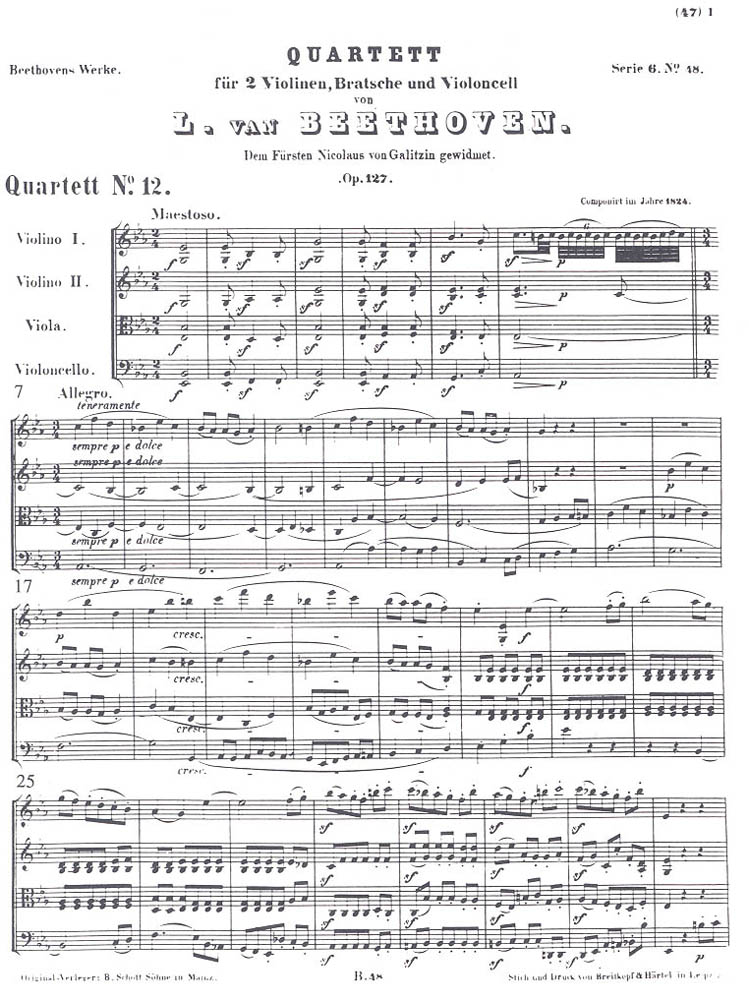
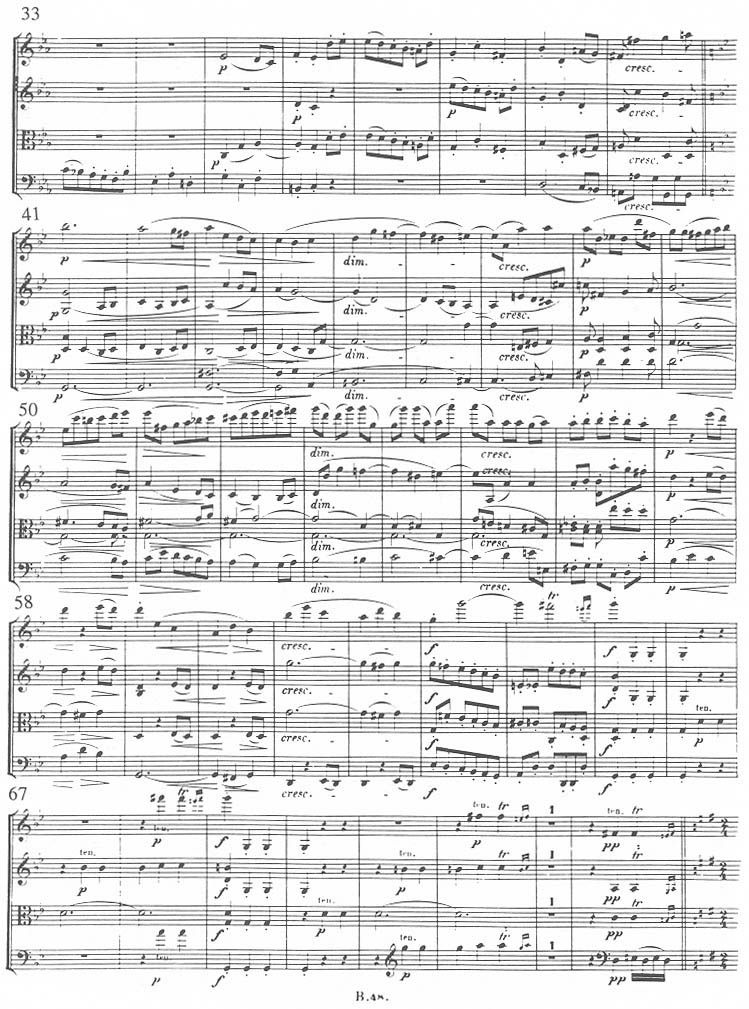
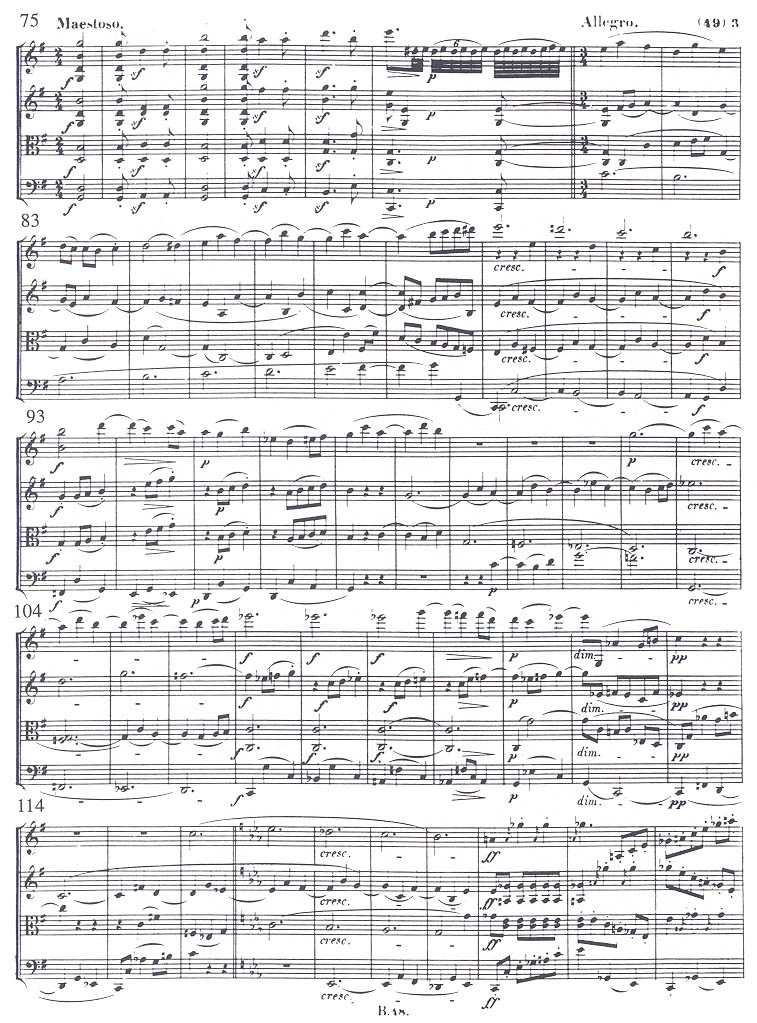
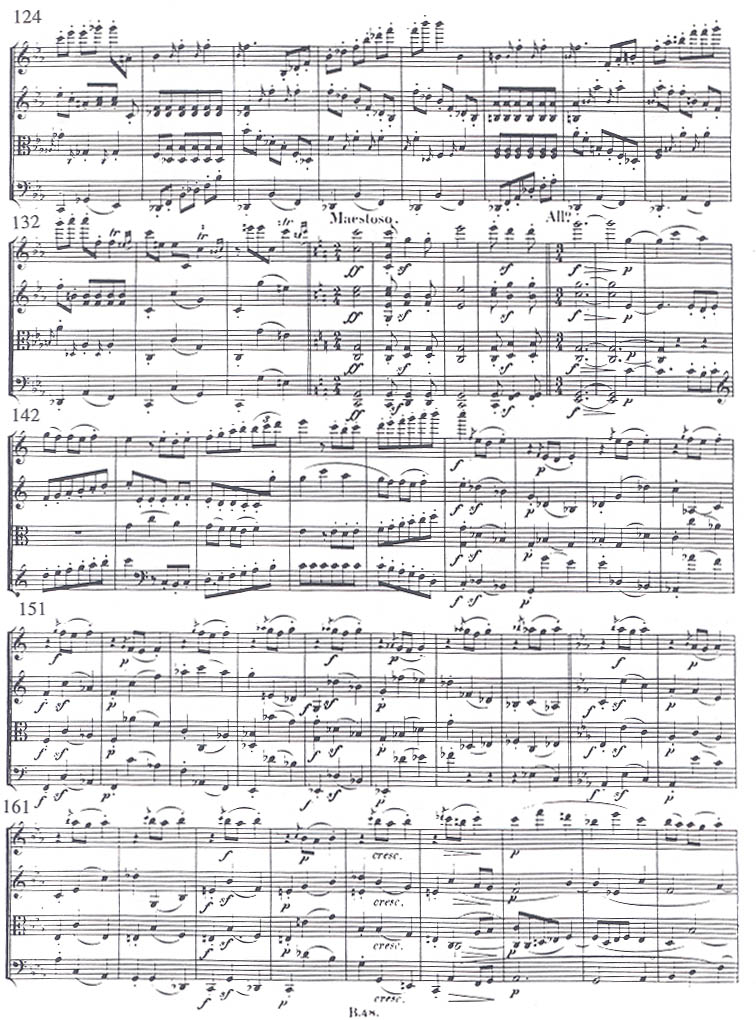
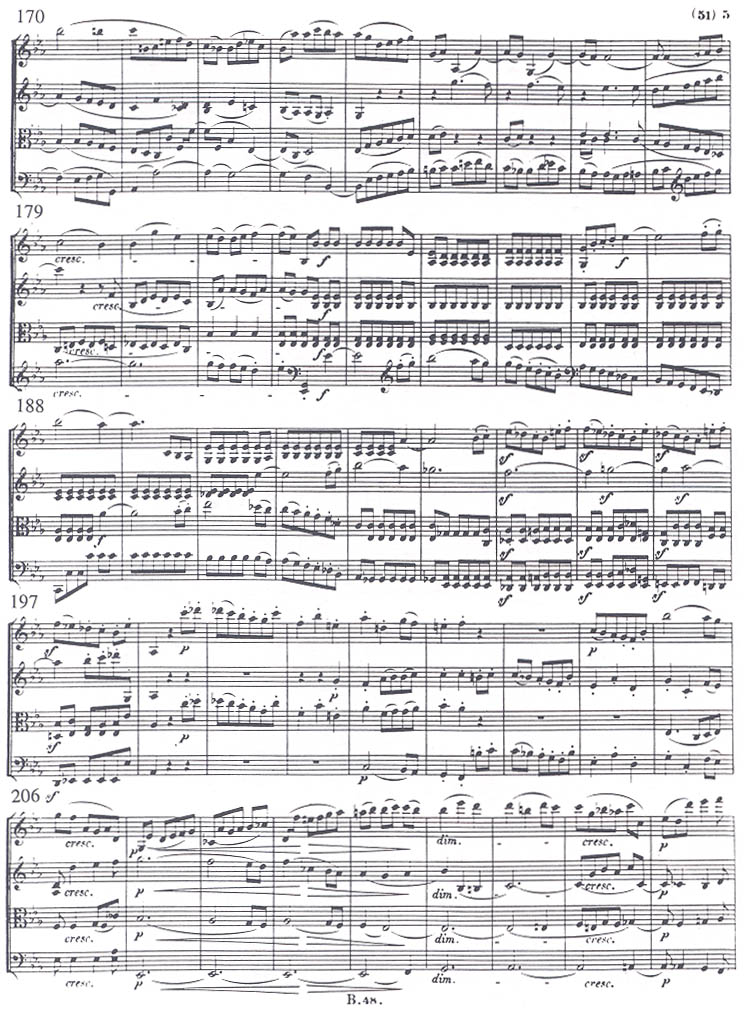
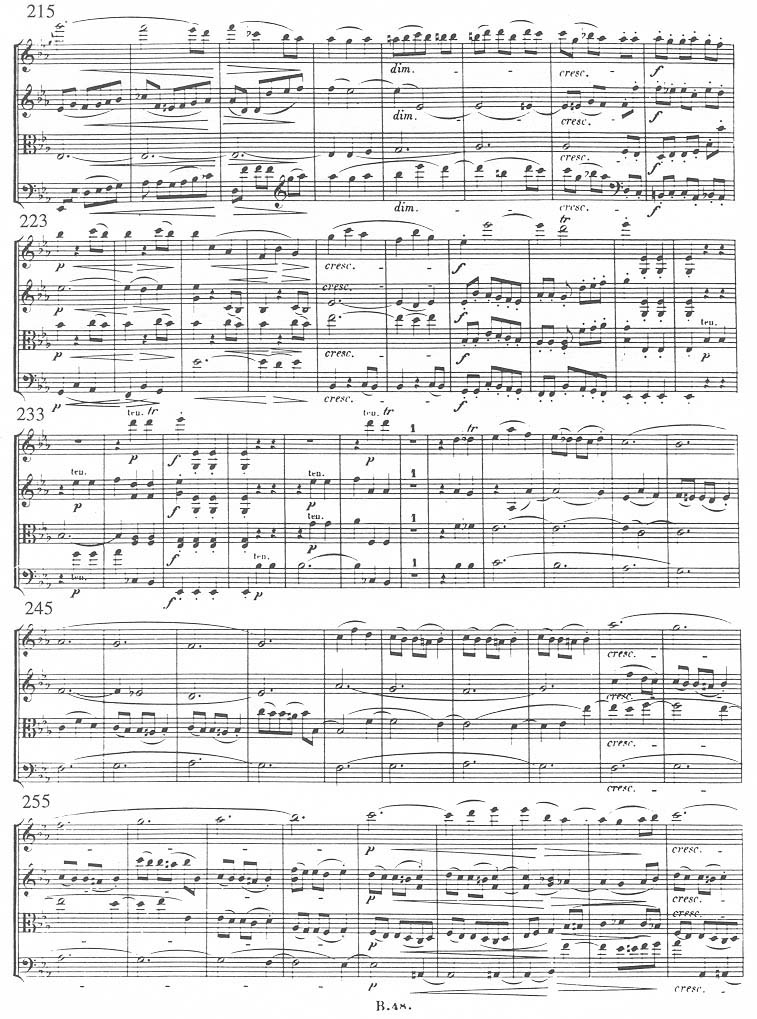
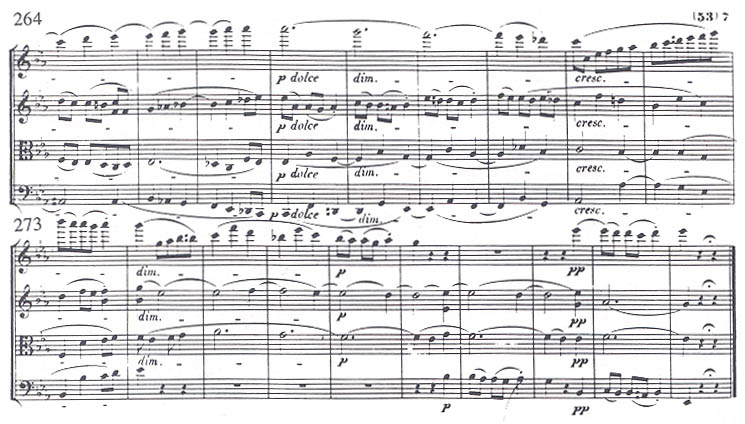
Reprinted by permission of the publisher from: Ludwig van Beethoven, Complete String Quartets (New York: Dover Publications, Inc., 1970).
The opening Maestoso pronounces the tonic emphatically, but utterly fails to provide a correspondingly stable metrical beginning for the movement. Syncopated sforzandi make it difficult to group durations into rational metrical units at first. By the time one captures a pulse, it dissolves in the cadenza-like m. 6. Only with the change to triple meter at the beginning of the Allegro does the music settle into a comfortable, periodic regularity. However, once underway, the exposition is quite regular (see the bar-grouping analysis in Figure 1).
Figure 1
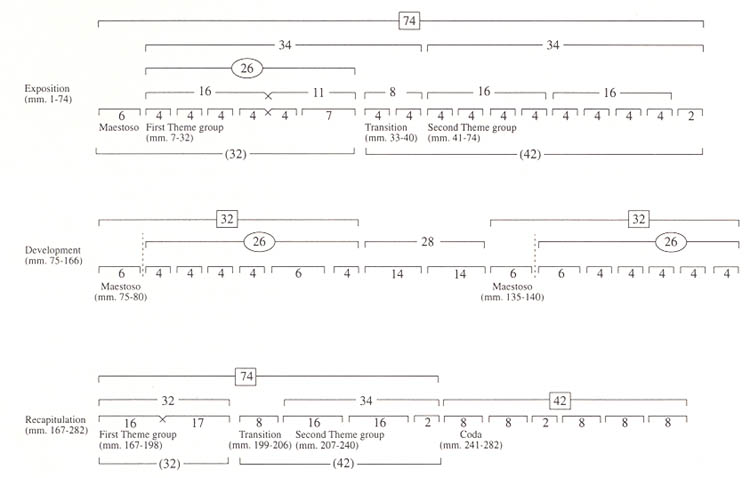
The lyrical theme in mm. 7-22 projects four times four bars, closing into a more assertive forte passage of eleven bars (mm. 22-32). (I will say more about the elision in m. 22, and the irregularity of the ensuing passage later.) The transition (mm. 33-40) presents a pair of four-bar groups, and excepting only the final two bars of the exposition, clear four-bar grouping is maintained throughout the entire second theme group (mm. 41-74).
The development begins with a varied restatement of the metrically unruly Maestoso. As in the exposition, four times four bars follow (mm. 81-96), but here the parallelism of grouping structure breaks down. It is possible to hear two-bar groups throughout the entire development, but they do not consistently combine in pairs as four-bar units; at various points, six-bar groups occur. The return of the Maestoso at m. 135 is again highly disruptive, but the retransition (mm. 147-166) projects five successive four-bar groups, restoring familiar and stable patterning in preparation for the recapitulation. The recapitulation (which does not begin with a statement of the Maestoso), continues this succession of four-bar groups to m. 182, where an elision occurs (corresponding to that in m. 22 of the exposition). The ensuing passage (mm. 182-198) is extended, running seventeen bars now, as opposed to eleven in the exposition. The transition and the entire second theme group (mm. 199-240) project exactly the same grouping structure as they did in the exposition: here, as before, we have an uninterrupted succession of ten four-bar groups, plus two final bars. Four-bar groups then resume in the coda, which begins in m. 241. A single irregularity (the six-bar group in mm. 253-258) constitutes the only disruption of four-bar grouping to the end of the movement.
Clearly, a good bit of the movement consists of successions of four-bar groups. If such regular grouping structure, in combination with the readily perceptible alternation of strong and weak bars, is what it takes to create hypermeter, then long stretches project clear two-, four-, and perhaps even eight-bar hypermeter. It is not difficult to enumerate the features of the musical surface which encourage grouping at various levels: repetition of melodic motives, antecedent-consequent construction, changing degrees of harmonic stability, and (not least) simple rhythmic parallelism—the almost sing-song quality created by multiple repetitions of rhythmic figures. As Kerman's remark about folksongs suggests, it is almost too easy to hear the gentle swing of the periodic rhythms created by these bar groups. But what about the irregular passages? What motivates disruptions of the prevailing regularity? Why do irregular passages occur when they do and why are they as long as they are?
First, consider the Maestoso. How is one to deal with this in hypermetric terms? If, for instance, we regard this as an expanded four-bar hypermeasure, it is still in a different meter and tempo from the remainder of the exposition, and thus stands apart from the main metrical scheme of the movement. In several important ways, however, the Maestoso is welded to the Allegro, which could hardly make an effective beginning without it. Cone claims that some introductions function as expanded upbeats, in a metaphorical sense.12 But here the metaphor does not seem particularly appropriate: the Maestoso begins with an emphatic tonic downbeat, and the off-tonic opening of the Allegro fails to discharge the accumulated energy of the introduction; rather, the subdominant surge carries across. Measure 7, for all its importance as a grouping boundary, is no structural downbeat.13
The Maestoso returns twice during the movement (as noted above): at the opening of the development, and again in m. 135. Some listeners, insensitive to changes in key and scoring, might mistake the second appearance of the Maestoso (at m. 75) for the beginning of a repeat of the exposition; the final Maestoso (m. 135) might possibly be mistaken for the beginning of a recapitulation. Others will relish these false signals, and will perhaps appreciate the unfolding of  , G, and C (the keys of the three Maestoso statements) as a large-scale projection of the top voice
, G, and C (the keys of the three Maestoso statements) as a large-scale projection of the top voice  , G, and C of the initial Maestoso. Most will notice a very important difference in the last statement of the Maestoso (mm. 135-140): the final melodic member of the passage is omitted, so that instead of climbing to the local subdominant, the music stops short on a first-inversion C harmony. But the changes of meter and tempo are notated such that this statement, like the other two, is effectively six bars long. This strange notation of the rhythm is highly suggestive: what else do the three statements of the Maestoso have in common?
, G, and C of the initial Maestoso. Most will notice a very important difference in the last statement of the Maestoso (mm. 135-140): the final melodic member of the passage is omitted, so that instead of climbing to the local subdominant, the music stops short on a first-inversion C harmony. But the changes of meter and tempo are notated such that this statement, like the other two, is effectively six bars long. This strange notation of the rhythm is highly suggestive: what else do the three statements of the Maestoso have in common?
As Figure 1 shows, each occurrence of the Maestoso is followed by a 26-bar group leading to an important articulation. The first leads to the powerful cadence in m. 32 (the first perfect authentic cadence in the movement), after which the transition begins. The second leads to one of the strongest cadences in the development, the forte C-minor arrival in m. 107. The third leads to the beginning of the recapitulation. Each Maestoso, then, might be regarded as the prefix of a strongly articulated 32-bar group. Such units, being made up of segments in different tempos and involving "irrational" internal subdivisions, severely challenge any conventional notion of meter. But their recurrence creates patterning of a sort, and contributes to a coherent overall design.
Next consider the disruptive passage at the end of the first theme group (mm. 22-32). It begins at a point of elision: locally, m. 22 is both the final bar of a four-bar group and the first bar of another four-bar group.14 The elision creates a reversal in the prevailing alternation of strong and weak bars: up to this point, odd-numbered bars sound strong, but after m. 22, even-numbered bars sound strong. Since this passage contains an odd number of measures, it accomplishes another reversal of strong/weak alternation, thus restoring the original pattern of odd-numbered bars sounding strong, beginning in m. 33. This does not, however, put the music back "in phase" with the previous four-bar hypermetric scheme. That is, if a listener adopts what Andrew Imbrie has called a "conservative" stance, and continues to count in fours from m. 7 through m. 33, the four-bar groups that begin in m. 33 do not start where they "ought to."15 They begin out of phase, either two bars too soon, or too late, as it were.
Compare the parallel passage (mm. 182-198) in the recapitulation. As in the exposition, it begins at a point of elision (m. 182) that reverses the strong and weak accentuation (odd bars were strong, but here even bars become strong). And since the passage again contains an odd number of bars, it again effects another reversal of strong/weak alternation, restoring the odd-bars strong scheme that had been in effect since the beginning of the recapitulation. This time, however, the disruption also enables the four-bar groups beginning in m. 199 to enter in phase with those at the opening of the recapitulation. At m. 199, the downbeat of a four-bar hypermeasure occurs in phase with those at the beginning of the recapitulation. The "conservative" listener who keeps track by continuing to count to four throughout the entire section will perhaps be comforted to find that the music "comes out all right" after all in m. 199. (By similar reasoning, a two-bar extension (mm. 257-258) in the coda compensates for the isolated two-bar group at the end of the recapitulation (mm. 239-240), such that the final twenty-four bars of the movement also occur in phase with the four-bar scheme that prevails at the beginning of the recapitulation.)
It may seem somewhat perverse to adopt this so-called "conservative" stance, and to count against the grain of local accentuation; admittedly, it feels unnatural. Yet even Tovey indulged in similar exercises as he attempted to make sense of the accentual patterning in Beethoven's sonatas, and one suspects that Beethoven delighted in creating such effects.16 That he should turn them to the service of a unique formal design in the first movement of Opus 127 typifies the quintessential classical aesthetic: the recapitulation and coda resolve metrical (and hypermetrical) tensions along with harmonic and thematic ones.
Figure 1 also illustrates several other large-scale patterns in the movement. If one discounts the opening Maestoso, the remainder of the exposition is exactly bisected at the beginning of the second theme group (m. 41).17 The development section is also symmetrical, consisting of two 32-bar groups surrounding a central 28-bar group. The midpoint of the development is articulated by the fortissimo diminished seventh chord and decisive textural change at m. 121. At a still more inclusive level, the symmetry continues, because the exposition and the recapitulation both comprise exactly 74 bars. Herein lies another consequence of the six-bar expansion of the first theme group in the recapitulation (mm. 182-198): it compensates for the omission of the Maestoso at the beginning of the recapitulation. The coda, at 42 bars, exactly matches the transition and second theme group in length. Recall that the beginning of the transition at m. 199 marks the point at which four-bar hypermeter is finally restored in phase. In sum, considering the presence of highly enigmatic and disruptive Maestoso passages and other hypermetrical irregularities, the coherence of the overall design is impressive indeed.
Faced with any disruption of hypermetrical regularity, a listener must decide whether to adopt a conservative stance, religiously maintaining one's counting in the hope that the composer will finally make things right again; or whether to accept changes in local accentuation and periodicity, in effect relocating the hypermetrical downbeat. Both ways of listening have their rewards, and if Jonathan Kramer is correct, we may actually be able to accommodate both alternatives through the interaction of short- and long-term memory.18 But any account of the causes and effects of local hypermetrical disruption must (it seems to me) also consider patterning at more inclusive levels of structure. As shown by the preceding analysis, irregular passages can be subsumed within larger patterning, the coherence of which may extend far beyond the relatively local levels at which unambiguous hypermeter operates.
It also seems important to consider whether or not hypermetrical downbeats occur in phase with other overall design schemes. The second movement of Op. 127 supplies an extraordinary example. The movement is a set of six variations on an eighteen-bar theme. Had Beethoven simply stated the theme followed by six straightforward variations, each of which ran eighteen bars, the movement would last 126 bars—and, indeed, that is exactly how long the movement is. However, a two-bar introduction opens the movement. As shown in Figure 2, one effect of the introduction is to throw the entire movement out of phase with a straightforward sequence of seven times eighteen bars.19
Figure 2

But further disruptions also occur: Variation 2 is internally expanded by two bars, Variation 4 has an extra final bar, and Variation 5 (perhaps better called a subdominant episode) is five bars "too short." To make matters still more complicated, some of the variations are linked together harmonically. The final eighteen bars are the only independently articulated span that occurs in phase with a hypothetical seven-times-eighteen bars plan. This passage begins like a sixth variation, but breaks off at a lengthy rest (in m. 118). When action resumes, the music sounds very much like a coda, starting on the dominant of the subdominant. Thus the final eight bars both complete the truncated final variation, and fill out a span implied by the movement's overall design.
The Lento variation movement of the F major quartet, Op. 135, provides an interesting comparison. The movement consists of a ten-bar theme and four ten-bar variations. A two-bar introduction before the theme is matched by a two-bar extension of the final cadence of the movement, so that the central più lento variation in the tonic minor forms the keystone of a symmetrical arch. Two-bar hypermeter prevails, undisturbed, throughout the entire movement, but the clear four-bar groups in the theme (and some of the variations) continually shift in and out of phase. Still another example is the variation movement of the Seventh Symphony: at the opening, the winds intone a tonic six-four chord for two bars as an introduction to the twenty-four-bar theme. The final variation is adjusted and altered to include this two-bar chord within its twenty-four-bar span.
* * * * *
Questions of how tonal structures and rhythmic grouping structures interact and how both correlate with meter will doubtless continue to occupy theorists for many years to come. What is needed, I believe, are more analytical studies of entire works, so that hypotheses advanced in general studies of rhythm and meter can be field tested and fine tuned.20 By studying passages in their full contexts, we can determine the factors that produce meter, and discern the causes and the limits of metric and hypermetric effects. I think that Joel Lester is essentially correct in asserting that meter in most tonal music is a relatively local, surface phenomenon, and that beyond a certain level, our ability to perceive metric organization tapers off.21 Hypermetrical analysis and a search for simple metrical prototypes may provide important insights into subtle rhythmic irregularities relatively close to the musical surface; but clearly, deeper levels are problematic. Patterning projected by grouping boundaries on more inclusive levels may lack the strict regularity and hierarchical consistency of meter, but it can nonetheless display remarkable coherence. Since such large-scale patterning can subsume and might—in some sense—explain irregularities in surface designs, we should take care that the practice of durational reduction and a preference for metrical regularity does not preclude consideration of alternative types of patterning.
An earlier version of this paper was read at the twelfth annual meeting of the Society for Music Theory in Austin, Texas, October 1989.
1Edward T. Cone, Musical Form and Musical Performance (New York: Norton, 1968).
2Edward T. Cone, "Musical Form and Musical Performance Reconsidered," Music Theory Spectrum 7 (1985): 149-158.
3Carl Schachter, "Rhythm and Linear Analysis: A Preliminary Study," Music Forum 4 (1976): 281-334; "Rhythm and Linear Analysis: Durational Reduction," Music Forum 5 (1980): 197-232; "Rhythm and Linear Analysis: Aspects of Meter," Music Forum 6/1 (1987): 1-60. Harald Krebs insightfully reviews the set (along with Rothstein's Phrase Rhythm in Tonal Music) in Music Theory Spectrum 14 (1992): 82-87.
4Ph.D. dissertation, Yale University, 1981. Rothstein thoroughly debunks the oft-repeated claim that Schenker neglected rhythm. His careful survey of Schenker's writings and analyses illuminates many important features of rhythm and counterpoint. Although his presentation of rhythmic implications of dissonance treatment in species counterpoint is exemplary, his discussion of meter and hypermeter involves (for this author) a somewhat problematic extension of Schenker's ideas.
5(New York: Schirmer Books, 1989). The review by Harald Krebs (cited in note 3, above) includes an even-handed assessment of some of the controversial issues surrounding hypermeter and hypermetrical analysis. See also Peter Kaminsky's thoughtful review in Journal of Musicological Research (special review supplement to Volume 12, 1992): 147-156.
6See Rothstein, pp. 97-99.
7"A Preliminary Study," 305.
8"Durational Reduction," 202-211.
9For further examples and a general discussion of relevant analytical techniques, see the author's "Large-Scale Rhythm and Classical Form," Music Theory Spectrum 12/2 (Fall 1990): 236-246. A companion study, "Balanced Interruption and the Formal Repeat," appeared in Music Theory Spectrum 15/1 (Spring 1993): 76-88.
10Basil Lam, Beethoven String Quartets (Seattle: University of Washington Press, 1975), vol. 2, 12.
11Joseph Kerman, The Beethoven Quartets (New York: Norton, 1979), 205.
12Musical Form and Musical Performance, 24. See also "Musical Form and Musical Performance Reconsidered," 156-158 for some further thoughts on the same proposition.
13In Beethoven Quartets, Kerman reminds us of the similar off-tonic openings of  Piano Sonatas, Opp. 31, No. 3 and 81a (p. 208). The off-tonic opening of the Vivace assai after the slow introduction of Haydn's "Surprise" Symphony (No. 94 in G Major) provides another instructive comparison.
Piano Sonatas, Opp. 31, No. 3 and 81a (p. 208). The off-tonic opening of the Vivace assai after the slow introduction of Haydn's "Surprise" Symphony (No. 94 in G Major) provides another instructive comparison.
14Readers may wish to try the experiment of locating hypermetrical downbeats at mm. 10, 14, and 18 (counting the four-bar groups "2-3-4-1" instead of "1-2-3-4"). In such a reading, there is no elision at m. 22, but rather a confirmation of the prevailing hypermetrical accentuation. However, it also implies that the periodicities of the hypermeter and the surface grouping structure are out of phase at the opening of the Allegro (and, as we shall see, throughout most of the work). In what follows, I assume that the accents of initiation which accrue to mm. 7, 11, and 15 make these "strong" bars. The possibility of such variant readings may be seen as both an advantage and a drawback of hypermetrical analysis.
15See Andrew Imbrie, "'Extra' Measures and Metrical Ambiguity in Beethoven," in Alan Tyson, ed. Beethoven Studies (New York: Norton, 1973), 45-66.
16See, for example, A Companion to Beethoven's Pianoforte Sonatas (London: Associated Board of the Royal Schools of Music, 1931).
17That m. 41 is a strong bar and the first of a four-bar group seems obvious. Thus when the melodic motive from m. 7 enters in m. 45, one hears it as beginning on a hypermetrical downbeat. This and subsequent appearances of the motive at the beginnings of four-bar groups (cello, m. 57; first violin, m. 61) tend to confirm the reading of m. 7 as strong.
18See his highly original discussion of hypermeter in The Time of Music (New York: Schirmer Books, 1988), 112-120.
19It is all the more fascinating to learn from Sieghard Brandenburg's study of the source materials for this quartet that this introduction was apparently added quite late in the genesis of the movement. A well developed sketch of the theme in quartet score (but lacking the two-bar introduction) is reproduced on p. 259 of his "Die Quellen zur Entstehungsgeschichte von Beethovens Streichquartett Es-Dur Op. 127," in M. Staehelin, ed. Beethoven-Jahrbuch 10 (Bonn: Beethovenhaus, 1983): 221-275. Of course, the theme itself displays clear four-bar groups (beginning in mm. 3, 7, 11, and 15). This periodicity is thrown out of phase by the two-bar opening, then restored by the "extra" echoes of the cadence figures in mm. 19-20. The local grouping structures in the subsequent variations are remarkably complex, and I will not attempt to map them here.
20Among recent additions to this literature, Richard Cohn's "The Dramatization of Hypermetric Conflicts in the Scherzo of Beethoven's Ninth Symphony," 19th-Century Music XV/3 (Spring 1992): 188-206, is exemplary in its clarity. Cohn offers important basic definitions one hopes will gain wide currency.
21Joel Lester, The Rhythms of Tonal Music (Carbondale: Southern Illinois University Press, 1986). Fred Lerdahl and Ray Jackendoff express essentially the same opinion in A Generative Theory of Music (Cambridge: MIT Press, 1983); but see Harald Krebs' review (cited in note 3 above) for a discussion of contrary opinions.


